Submarine Geomorphology of the Southwestern Sardinian Continental Shelf (Mediterranean Sea): Insights into the Last Glacial Maximum Sea-Level Changes and Related Environments
Abstract
:1. Introduction
2. Geological and Structural Settings
3. Geomorphological Setting
4. Materials and Methods
4.1. Seismic Data
4.2. Multibeam, Singlebeam, and Side-Scan Sonar Data
4.3. Direct Seabed Observations
4.4. Dredging and Shell Sampling for Radiocarbon Analysis
4.5. Aerial and Uncrewed Aerial Vehicle Inland Remote Sensing
4.6. Data Processing and Cartography
5. Results
5.1. Structural Landforms
5.1.1. Volcanic Landforms
5.1.2. Palaeo-Cliffs and Related Landforms
5.1.3. Fossil Palaeo-Valleys
5.1.4. Palaeo-Lagoon
5.1.5. Beachrocks
6. Discussion
6.1. Last Glacial Maximum (LGM) Coastal Palaeo-Landscape
6.2. Post-Glacial Palaeo-Landscape Evolution
6.3. Younger Dryas Coastal Landscape
6.4. Lower Holocene Coastal Palaeo-Landscape
7. Conclusions
- During the LGM the central-southern sector of the investigated area was characterized by a large promontory showing tectonically controlled high rocky coasts affected by intense fracturing and rotational landslides.
- Deep rias, set along faults, interrupt the cliffs’ continuity during the same period. A large lagoon, with a peri-littoral thanatocenosis that hosted species of cold waters, formed at the bottom of one of these Ria bays (Figure 12).
- In the northern sector was there a wide river valley, while continuing towards north -east the coast became low and sandy with lagoon-barrier systems (LGM).
- The rapid eustatic sea-level rise during deglaciation, probably associated with extreme weather and sea conditions, has favoured the development of rotational landslides and debris avalanches on the cliffs (Figure 9).
- During the Younger Dryas, the eustatic oscillations between the depths of 50 and 45 m led to the construction of very thick littoral spits that extended continuously for tens of kilometers to the north (beachrocks).
- During the Holocene, the landscape comprised a vast coastal plain with lagoons that extended between the present-day islands of San Pietro and Sant’Antioco and the mainland. This landscape played an important role in the movements of Mesolithic groups along the coast. In fact, the presence of Mesolithic burials (about 40 km away), including ocher and jasper artifacts from the Island of San Pietro, shows that the Mesolithic inhabitants could reach the jasper outcrops by walking along a coast characterized by long beaches, lagoons and back-littoral dunes (Figure 15).
Author Contributions
Funding
Institutional Review Board Statement
Informed Consent Statement
Data Availability Statement
Acknowledgments
Conflicts of Interest
References
- Shackleton, N.J. The 100,000-year ice-age cycle identified and found to lag temperature, carbon dioxide and orbital eccentricity. Science 2000, 289, 1897–1902. [Google Scholar] [CrossRef] [PubMed] [Green Version]
- Micallef, A.; Foglini, F.; Le Bas, T.; Angeletti, L.; Maselli, V.; Pasuto, A.; Taviani, M. The submerged palaeolandscape of the Maltese Islands: Morphology, evolution and relation to Quaternary environmental change. Mar. Geol. 2013, 335, 129–147. [Google Scholar] [CrossRef]
- Prampolini, M.; Foglini, F.; Biolchi, S.; Devoto, S.; Angelini, S.; Soldati, M. Geomorphological mapping of terrestrial and marine areas, northern Malta and Comino (central Mediterranean Sea). J. Maps 2017, 13, 457–469. [Google Scholar] [CrossRef]
- Prampolini, M.; Savini, A.; Foglini, F.; Soldati, M. Seven good reasons for integrating terrestrial and marine spatial datasets in changing environments. Water 2020, 12, 2221. [Google Scholar] [CrossRef]
- Tallavaaraa, M.; Miska, L.; Korhonenc, N.; Järvinend, H.; Seppäb, H. Human population dynamics in Europe over the Last Glacial Maximum. Proc. Natl. Acad. Sci. USA 2015, 112, 8232–8237. [Google Scholar] [CrossRef] [Green Version]
- Benjamin, J. Submerged prehistoric landscapes and underwater site discovery: Reevaluating the ‘danish model’ for international practice. J. Island Coast. Archaeol. 2010, 5, 253–270. [Google Scholar] [CrossRef]
- Lecca, L.; Carboni, S.; Scarteddu, R.; Sechi, F.; Tilocca, G.; Pisano, S. Schema stratigrafico della piattaforma continentale occidentale e meridionale della Sardegna. Mem. Soc. Geol. Ital. 1986, 36, 31–40. [Google Scholar]
- Orrù, P.; Ulzega, A. Carta geomorfologica della piattaforma continentale e delle coste del Sulcis—Sardegna sud occidentale. Scala 1:100,000. STEF 1990, (in press). [Google Scholar]
- Orrù, P.; Ulzega, A. Geomorfologia costiera e sottomarina della baia di Funtanamare (Sardegna sud-occidentale). Geogr. Fis. Din. Quat. 1986, 9, 59–67. [Google Scholar]
- Miccadei, E.; Orru, P.E.; Piacentini, T.; Mascioli, F.; Puliga, G. Geomorphological map of the Tremiti Islands (Puglia, Southern Adriatic Sea, Italy), scale 1:15,000. J. Maps 2012, 8, 74–87. [Google Scholar] [CrossRef] [Green Version]
- Foglini, F.; Prampolini, M.; Micallef, A.; Angeletti, L.; Vandelli, V.; Deidun, A.; Soldati, M.; Taviani, M. Late Quaternary coastal landscape morphology and evolution of the Maltese Islands (Mediterranean Sea) reconstructed from high-resolution seafloor data. In Geology and Archaeology: Submerged Landscapes of the Continental Shelf; Harff, J., Bailey, G., Lüth, L., Eds.; Special Publication; Geological Society: London, UK, 2016; Volume 411, pp. 77–95. [Google Scholar]
- Lambeck, K.; Antonioli, F.; Anzidei, M.; Ferranti, L.; Leoni, G.; Scicchitano, G.; Silenzi, S. Sea level change along italian coast during Holocene and a projection for the future. Quat. Int. 2011, 232, 250–257. [Google Scholar] [CrossRef]
- Stocchi, P.; Spada, G. Glacio and hydro-isostasy in the Mediterranean Sea: Clark’s zones and role of remote ice sheets. Ann. Geophys. 2007, 50, 741–761. [Google Scholar]
- Antonioli, F.; Ferranti, L.; Fontana, A.; Amorosi, A.; Bondesan, A.; Braitenberg, C.; Dutton, A.; Fontolan, G.; Furlani, S.; Lambeck, K.; et al. Holocene relative sea-level changes and vertical movements along the Italian and Istrian coastlines. Quat. Int. 2009, 206, 102–133. [Google Scholar] [CrossRef]
- Lambeck, K.; Rouby, H.; Purcell, A.; Sun, Y.; Sambridge, M. Sea level and global ice volumes from the last glacial maximum to the Holocene. Proc. Natl. Acad. Sci. USA 2014, 111, 15296–15303. [Google Scholar] [CrossRef] [PubMed] [Green Version]
- Rovere, A.; Stocchi, P.; Vacchi, M. Eustatic and relative sea level changes. Curr. Clim. Chang. Rep. 2016, 2, 221–231. [Google Scholar] [CrossRef] [Green Version]
- Mann, T.; Bender, M.; Lorscheid, T.; Stocchi, P.; Vacchi, M.; Switzer, A.; Rovere, A. Relative sea-level data from the SEAMIS database compared to ICE-5G model predictions of glacial isostatic adjustment. Data Brief 2019, 27, 112–125. [Google Scholar] [CrossRef] [PubMed]
- Carminati, E.; Doglioni, C. Mediterranean tectonics. In Encyclopedia of Geology; Elsevier: Amsterdam, The Netherlands, 2005; pp. 135–146. [Google Scholar]
- Gattacceca, J.; Deino, A.; Rizzo, R.; Jones, D.S.; Henry, B.; Beaudoin, B.; Vadeboin, F. Miocene rotation of Sardinia: New paleomagnetic and geochronological constraints and geodynamic implications. Earth Planet. Sci. Lett. 2007, 258, 359–377. [Google Scholar] [CrossRef]
- Maselli, V.; Trincardi, F. Large-scale single incised valley from a small catchment basin on the western Adriatic margin (central Mediterranean Sea). Glob. Planet. Chang. 2013, 100, 245–262. [Google Scholar] [CrossRef]
- Sikora, M.; Mihanović, H.; Vilibić, I. Palaeo-coastline of the Central Eastern Adriatic Sea, and Palaeo-Channels of the Cetina and Neretva rivers during the last glacial maximum. Acta Adriat. 2014, 55, 3–18. [Google Scholar]
- Zecchin, M.M.; Ceramicola, S.; Lodolo, E.; Casalbore, D.; Chiocci, F.L. Episodic rapid sea-level rises on the central Mediterranean shelves after the last glacial maximum: A review. Mar. Geol. 2015, 369, 212–223. [Google Scholar] [CrossRef]
- Chiocci, F.L.; Romagnoli, C. Terrazzi deposizionali sommersi nelle Isole Eolie (Sicilia). In Atlante dei Terrazzi Deposizionali Sommersi Lungo le Coste Italiane. Memorie Descrittive Della Carta Geologica d’Italia; Chiocci, F.L., D’Angelo, S., Romagnoli, C., Eds.; APAT: Rome, Italy, 2004; Volume 58, pp. 81–114. [Google Scholar]
- Caruso, A.; Cosentino, C.; Pierre, C.; Sulli, A. Sea level change during the last 41 ka in the outher shelf of southern Tyrrhenian Sea. Quat. Int. 2011, 232, 122–131. [Google Scholar] [CrossRef] [Green Version]
- Casalbore, D.; Falese, F.; Martorelli, E.; Romagnoli, C.; Chiocci, F.L. Submarine depositional terraces in the Tyrrhenian Sea as a proxy for paleo-sea level reconstruction: Problems and perspective. Quat. Int. 2017, 439, 169–180. [Google Scholar] [CrossRef]
- Lo Presti, V.; Antonioli, F.; Palombo, M.R.; Agnesi, V.; Biolchi, S.; Calcagnile, L.; Di Patti, C.; Donati, S.; Furlani, S.; Merizzi, J.; et al. Palaeogeographical evolution of the Egadi Islands (western Sicily, Italy). Implications for late Pleistocene and early Holocene sea crossings by humans and other mammals in the western Mediterranean. Earth. Sci. Rev. 2019, 194, 160–181. [Google Scholar] [CrossRef]
- Pepe, F.; Bertotti, G.; Ferranti, L.; Sacchi, M.; Collura, A.M.; Passaro, S.; Sulli, A. Pattern and rate of post-20 ka vertical tectonic motion around the Capo Vaticano Promontory (W Calabria, Italy) based on offshore geomorphological indicators. Quat. Int. 2014, 332, 85–98. [Google Scholar] [CrossRef] [Green Version]
- Furlani, S.; Antonioli, F.; Biolchi, S.; Gambin, T.; Gauci, R.; Lo Presti, V.; Anzidei, M.; Devoto, S.; Palombo, M.; Sulli, A. Holocene sea level change in Malta. Quat. Int. 2013, 288, 146–157. [Google Scholar] [CrossRef]
- Prampolini, M.; Foglini, F.; Micallef, A.; Soldati, M.; Taviani, M. Malta’s submerged landscapes and landforms. In Landscapes and Landforms of the Maltese Islands. World Geomorphological Landscapes; Gauci, R., Schembri, J.A., Eds.; Springer: Cham, Switzerland, 2019; pp. 117–128. [Google Scholar]
- Orrù, P.E.; Deiana, G.; Taviani, M.; Todde, T. Palaeoenvironmental reconstruction of the Last Glacial Maximum coastline on the San Pietro continental shelf (Sardinia SW). Rend. Online Soc. Geol. Ital. 2012, 21, 1182–1184. [Google Scholar]
- Cau, A.; Follesa, M.C.; Cannas, R.; Sacco, F.; Orrù, P.E.; Deiana, G.; Todde, S.; Cau, A.; Enrico, P. Preliminary data on habitat characterization relevance for red coral conservation and management. Ital. J. Geosci. 2013, 134, 60–68. [Google Scholar] [CrossRef]
- Cau, A.; Follesa, M.C.; Moccia, D.; Alvito, A.; Bo, M.; Angiolillo, M.; Canese, S.; Paliaga, M.E.; Orrù, P.E.; Sacco, F.; et al. Deepwater corals biodiversity along roche du large ecosystems with different habitat complexity along the south Sardinia continental margin (CW Mediterranean Sea). Mar. Biol. 2015, 162, 1865–1878. [Google Scholar] [CrossRef]
- Pasci, S.; Pertusati, P.C.; Salvadori, I.; Medda, F.; Murtas, A.; Rizzo, R.; Uras, V.; Orrù, P.E.; Deiana, G.; Puliga, G. Geological Map of Italty. Scale 1:50,000. Scheet 555 “Iglesias”; ISPRA-Servizio Geologico Nazionale: Roma, Italy, 2015. [Google Scholar]
- Deiana, G.; Meleddu, A.; Paliaga, E.; Todde, S.; Orrù, P. Continental slope geomorphology: Landslides and pockforms of Southern Sardinian margin (italy). Geogr. Fis. Dinam. Quat. 2016, 39, 129–136. [Google Scholar]
- Rizzo, R.; Garbarino, C.; Salvadori, I.; Patta, D.; Orrù, P.E.; Deiana, G.; Pulga, G. Geological Map of Italty. Scale 1:50,000. Scheet 563 “Isola di San Pietro”; ISPRA-Servizio Geologico Nazionale: Roma, Italy, 2016. [Google Scholar]
- Lecca, L. La piattaforma continentale miocenico-quaternaria del margine occidentale sardo: Blocco diagramma sezionato. Rend. Sem. Fac. Sci. Univ. Cagliari. 2000, 1, 49–70. [Google Scholar]
- Finetti, I.; Morelli, C. Geophysical Exploration of the Mediterranean Sea. Boll. Geof. Teor. Appl. 1973, 60, 263–342. [Google Scholar]
- Ryan, W.B.F.; Hsü, K.J.; Cita, M.B.; Dumitrica, P.; Lort, J.; Maync, W.; Nesteroff, W.D.; Pautot, G.; Stradner, H.; Wezel Forese, C. Boundary of Sardinia Slope with Balearic Abyssal Plain—Sites 133 and 134. Deep Sea Drill. Proj. Rep. 1973, XIII, 465–514. [Google Scholar]
- Fanucci, F.; Fierro, G.; Ulzega, A.; Gennesseaux, M.; Rehault, J.P.; Viaris De Lesegno, L. The continental shelf of Sardinia: Structure and sedimentary characteristics. Boll. Soc. Geol. Ital. 1976, 95, 1201–1217. [Google Scholar]
- Carta, M.; Lecca, L.; Ferrara, C. La piattaforma continentale della Sardegna. Studi geociacimentologici e di valorizzazione dei minerali contenuti. CNR, P.F. “Oceanografia e fonfi marini”. Final Tech. Rep. 1986, 119–218. [Google Scholar]
- Finetti, I.R.; Del Ben, A.; Fais, S.; Forlin, E.; Klingelè, E.; Lecca, L. Crustal tectono-stratigraphic setting and geodynamics of the Corso-Sardinian Block from new CROP seismic data. Crop Proj. 2005, 1, 413–446. [Google Scholar]
- Cherchi, A.; Montadert, L. Oligo-Miocene rift of Sardinia and the early history of the Western Mediterranean Basin. Nature 1982, 298, 736–739. [Google Scholar] [CrossRef]
- Fais, S.; Klingele, E.E.; Lecca, L. Structural features of the south-western Sardinian shelf (Western Mediterranean) deduced from aeromagnetic and high-resolution reflection seismic data. Eclogae Geol. Helv. 2002, 95, 169–182. [Google Scholar]
- Casula, G.; Cherchi, A.; Montadert, L.; Murru, M.; Sarria, E. The Cenozoic graben system of Sardinia (Italy): Geodynamic evolution from new seismic and field data. Mar. Petrol. Geol. 2001, 18, 863–888. [Google Scholar] [CrossRef]
- Faccenna, C.; Speranza, F.; D’Ajello Caracciolo, F.; Mattei, M.; Oggiano, G. Extensional tectonics on Sardinia (Italy): Insights into the arc-back-arc transitional regime. Tectonophysics 2002, 356, 213–232. [Google Scholar] [CrossRef]
- Pondrelli, S.; Salimbeni, S.; Ekström, G.; Morelli, A.; Gasperini, P.; Vannucci, G. The Italian CMT dataset from 1977 to the present. Phys. Earth Planet. Inter. 2006, 159, 286–303. [Google Scholar] [CrossRef] [Green Version]
- Cioni, R.; Salaro, L.; Pioli, L. The Cenozoic volcanism of San Pietro Island (Sardinia, Italy). Rend. Sem. Fac. Sci. Univ. Cagliari. 2001, 71, 149–163. [Google Scholar]
- Cita, M.B.; Ryan, W.B.F. Messinian erosional surfaces in the Mediterranean. Mar. Geol. 1978, 27, 193–365. [Google Scholar]
- Haq, B.U.; Hardenbol, J.; Vail, P. Chronology of fluctuating sea levels since the Triassic (250 million years ago to present). Science 1987, 235, 1156–1167. [Google Scholar] [CrossRef] [PubMed] [Green Version]
- Ceramicola, S.; Praeg, D.; Cova, A.; Accettella, D.; Zecchin, M. Seafloor distribution and last glacial to postglacial activity of mud volcanoes on the Calabrian accretionary prism, Ionian Sea. Geo Mar. Lett. 2014, 34, 111–129. [Google Scholar] [CrossRef]
- De Muro, S.; Orrù, P. Il contributo delle beachrock nello studio della risalita del mare olocenico. Le beachrock post-glaciali della Sardegna nord orientale. J. Quat. Sci. 1998, 11, 1–21. [Google Scholar]
- Kelletat, D. Beachrock as sea-level indicator? Remarks from a geomorphological point of view. J. Coast. Res. 2006, 22, 1555–1564. [Google Scholar] [CrossRef]
- Carboni, S.; Lecca, L.; Ferrara, C. La discordanza Versiliana sulla piattaforma continentale occidentale della Sardegna. Boll. Soc. Geol. Ital. 1989, 108, 503–519. [Google Scholar]
- Carboni, S.; Lecca, L. Upper Pleistocene sea-level lowstands in the continental shelf of western Sardinia (Italy). Int. Union Quat. Res. Comm. Quat. Shorel. Subcomm. Mediterr. Black Sea Shorel. 1992, 14, 57–65. [Google Scholar]
- Lecca, L.; De Muro, S.; Pascucci, V.; Carboni, S.; Tilocca, G.; Andreucci, S.; Pusceddu, G. Note illustrative della Carta Geologica d’Italia alla scala 1:50.000, Foglio 528 Oristano. ISPRA 2016, 152–156. (in press). [Google Scholar]
- Palombo, M.R.; Antonioli, F.; Lo Presti, V.; Mannino, M.A.; Melis, R.T.; Orrù, P.; Stocchi, P.; Talamo, S.; Quarta, G.; Calcagnile, L.; et al. The late Pleistocene to Holocene palaeogeographic evolution of the Porto Conte area: Clues for a better understanding of human colonization of Sardinia and faunal dynamics during the last 30 ka. Quat. Int. 2017, 439, 117–140. [Google Scholar] [CrossRef]
- Di Gregorio, F.; Orrù, P.E.; Piras, G.; Puliga, G. Carta geomorfologica costiera e marina. Isola di San Pietro (Sardegna sud-occidentale)—Scala 1:25.000. Boll. Assoc. Ital. Cartogr. 2010, 138, 311–326. [Google Scholar]
- Conforti, A.; Budillon, F.; Tonielli, R.; De Falco, G. A newly discovered Pliocene volcanic field on the western Sardinia continental margin (western Mediterranean). Geo Mar. Lett. 2016, 36, 1–14. [Google Scholar] [CrossRef]
- Putignano, L.; Orrù, P.E. Note Illustrative della Carta Geologica d’Italia 1:50.000. Foglio 465—Isola di Procida. Area Marina. ISPRA 2010, (in press). [Google Scholar]
- Putignano, M.L.; Orrù, P.E.; Schiattarella, M. Palaeoenvironmental reconstruction of Holocene coastline of Procida Island, Bay of Naples. Quat. Int. 2012, 332, 115–125. [Google Scholar] [CrossRef]
- Di Vito, M.A.; Isaia, R.; Orsi, G.; Southon, J.; De Vita, S.; D’Antonio, M.; Pappalardo, L.; Piochi, M. Volcanism and deformation since 12,000 years at the Campi Flegrei caldera (Italy). J. Volcanol. Geotherm. Res. 1999, 91, 221–246. [Google Scholar] [CrossRef]
- Keir, D.; Pagli, C.; Bastow, I.D.; Ayele, A. The magma-assisted removal of Arabia in Afar: Evidence from dike injection in the Ethiopian rift captured using InSAR and seismicity. Tectonics 2011, 30, 3–13. [Google Scholar] [CrossRef] [Green Version]
- Ayele, A.; Keir, D.; Ebinger, C.; Tim, J.; Stuart, W.G.; Roger, B.W.; Jacques, E.; Ogubazghi, G.; Sholan, J. Mega-dike emplacement in the Manda-Harraro nascent oceanic rift (Afar depression). Geophys. Res. Lett. 2009, 36, 1–5. [Google Scholar] [CrossRef] [Green Version]
- Sunamura, T. The Geomorphology of Rocky Coasts; Wiley: Chichester, UK, 1992. [Google Scholar]
- Savini, A.; Corselli, C. High-resolution bathymetry and acoustic geophysical data from Santa Maria di Leuca Cold Water Coral province (Northern Ionian Sea—Apulian continental slope). Deep Sea Res. Part II Top. Stud. Oceanogr. 2010, 57, 326–344. [Google Scholar] [CrossRef]
- Prampolini, M.; Gauci, C.; Micallef, A.S.; Selmi, L.; Vandelli, V.; Soldati, M. Geomorphology of the north-eastern coast of Gozo (Malta, Mediterranean Sea). J. Maps 2018, 14, 402–410. [Google Scholar] [CrossRef]
- Soldati, M.; Barrows, T.T.; Prampolini, M.; Fifield, K.L. Cosmogenic exposure dating constraints for coastal landslide evolution on the Island of Malta (Mediterranean Sea). J. Coast. Conserv. 2018, 22, 831. [Google Scholar] [CrossRef] [Green Version]
- Castedo, R.; Paredes, C.; De la Vega-Panizo, R.; Santos, A.P. The Modelling of Coastal Cliffs and Future Trends; Hydro-Geomorphology-Models and Trends; InTech: Houston, TX, USA, 2017. [Google Scholar]
- Ohneiser, C.; Florindo, F.; Stocchi, P.; Roberts, A.P.; De Conto, R.M.; Pollard, D. Antarctic glacio-eustatic contributions to late Miocene Mediterranean desiccation and reflooding. Nat. Commun. 2015, 6, 1–10. [Google Scholar] [CrossRef] [PubMed]
- López Correa, M.; Montagna, P.; Vendrell-Simón, B.; McCulloch, M.; Taviani, M. Stable isotopes (δ18O and δ13C), trace and minor element compositions of Recent scleractinians and Last Glacial bivalves at the Santa Maria di Leuca deep-water coral province, Ionian Sea. Deep Sea Res. Part II Top. Stud. Oceanogr. 2010, 57, 471–486. [Google Scholar] [CrossRef]
- Siani, G.; Paterne, M.; Arnold, M.; Bard, E.; Métivier, B.; Tisnerat, N.; Bassinot, F. Radiocarbon Reservoir Ages in the Mediterranean Sea and Black Sea. Radiocarbon 2000, 42, 271–280. [Google Scholar] [CrossRef] [Green Version]
- Ferranti, L.; Antonioli, F.; Amorosi, A.; Dai Prà, G.; Mastronuzzi, G.; Mauz, B.; Monaco, C.; Orrù, P.E.; Pappalardo, M.; Radtke, U.; et al. Markers of the last interglacial sea-level high stand along the coast of Italy: Tectonic implications. Quat. Int. 2006, 145, 30–54. [Google Scholar] [CrossRef]
- Antonioli, A.; Lo Presti, V.; Rovere, A.; Ferranti, L.; Anzidei, M.; Furlani, S.; Mastronuzzi, G.; Orru, P.E.; Scicchitano, G.; Sannino, G.; et al. Tidal notches in Mediterranean Sea: A comprehensive analysis. Quat. Sci. Rev. 2015, 119, 1–19. [Google Scholar] [CrossRef]
- Castedo, R.; William, M.; Lawrence, J.; Paredes, C. A new process–response coastal recession model of soft rock cliffs. Geomorphology 2012, 177, 128–143. [Google Scholar] [CrossRef]
- Sunamura, T. A relationship between wave-induced cliff erosion and erosive force of waves. J. Geol. 1977, 85, 613–618. [Google Scholar] [CrossRef]
- Kageyama, M.; Valdes, P.J.; Ramstein, G.; Hewitt, C.; Wyputta, U. Northern Hemisphere Storm Tracks in Present Day and Last Glacial Maximum Climate Simulations: A Comparison of the European PMIP models. J. Clim. 1999, 12, 742–760. [Google Scholar] [CrossRef]
- Atzeni, A. Effetti idrodinamici sulle spiagge della costa occidentale della Sardegna. Studi Costieri 2003, 7, 61–80. [Google Scholar]
- Sulis, A.; Annis, A. Morphological response of a sandy shoreline to a natural obstacle at Sa Mesa Longa Beach, Italy. Coast. Eng. 2014, 84, 10–22. [Google Scholar] [CrossRef]
- Bini, C.; Martini, F.; Pitzalis, G.; Ulzega, A. Sa Coa de Sa Multa e Sa Pedrosa-Pantallinu: Due “paleosuperfici” clactoniane in Sardegna; Atti della XXX Riunione Scientifica “Paleosuperfici del Pleistocene e dell’Olocene in Italia”: Firenze, Italy, 1993; pp. 179–196. [Google Scholar]
- Mussi, M.; Melis, R.T. Santa Maria in Acquas e le problematiche del Paleo/itico superiore in Sardegna. Origini 2004, XXIV, 67–94. [Google Scholar]
- Melis, R.T.; Mussi, M. Mesolithic burials at S’Omu e S’Orku (SOMK) on the south-western coast of Sardinia. In Mesolithic Burials—Rites, Symbols and Social Organisation of Early Postglacial Communities; Grünberg, J.M., Gramsch, B., Larsson, L., Orschiedt, J., Meller, H., Eds.; International Conference Haale (Saale): Halle, Germany, 2016; pp. 733–740. [Google Scholar]
- Melis, R.; Galheb, B.; Boldrini, R.; Palombo, M.R. The Grotta dei Fiori (Sardinia, Italy) stratigraphical successions: A key for inferring palaeoenvironment evolution and updating the biochronology of the Pleistocene mammalian fauna from Sardinia. Quat. Int. 2013, 288, 81–96. [Google Scholar] [CrossRef]
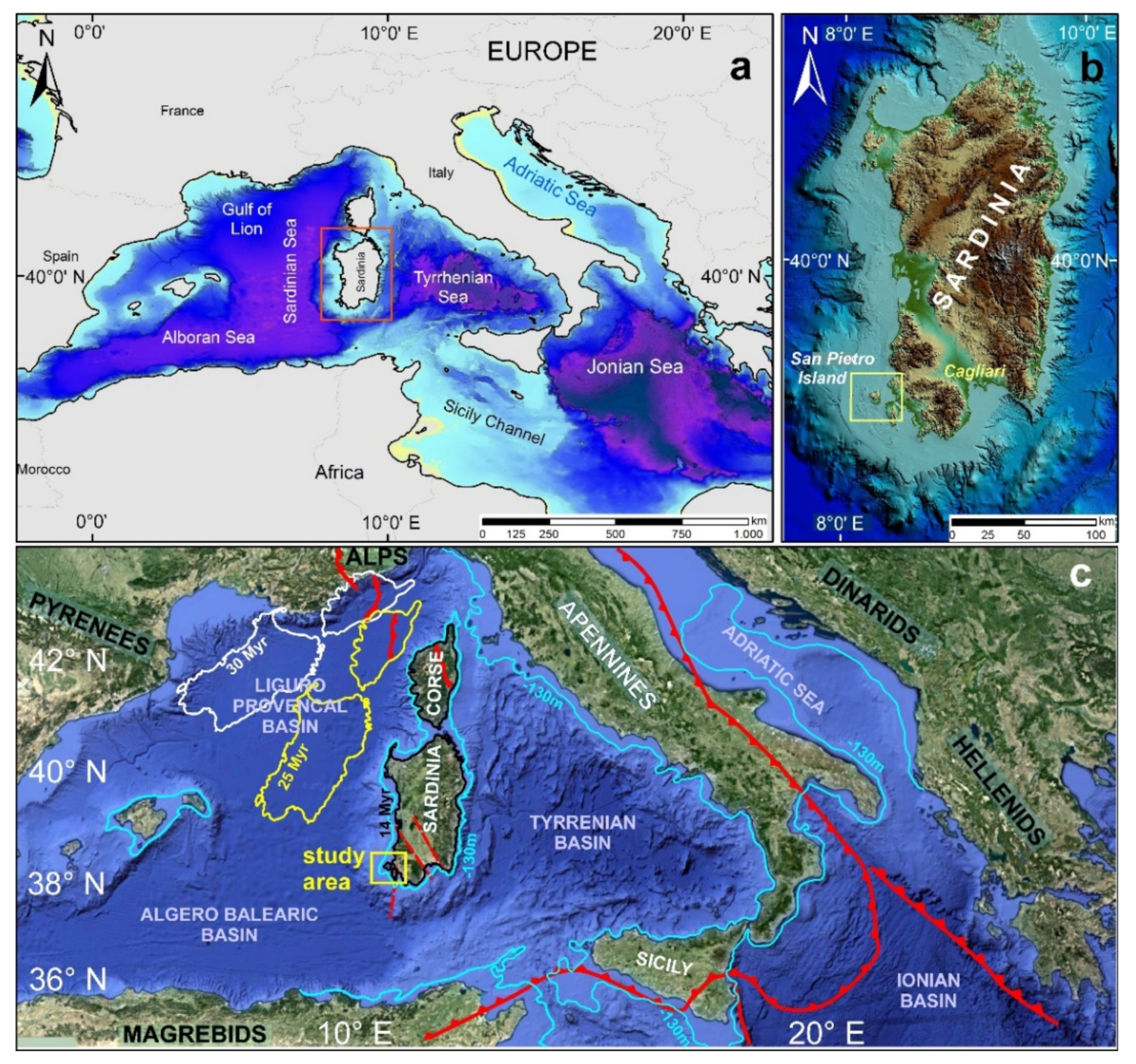

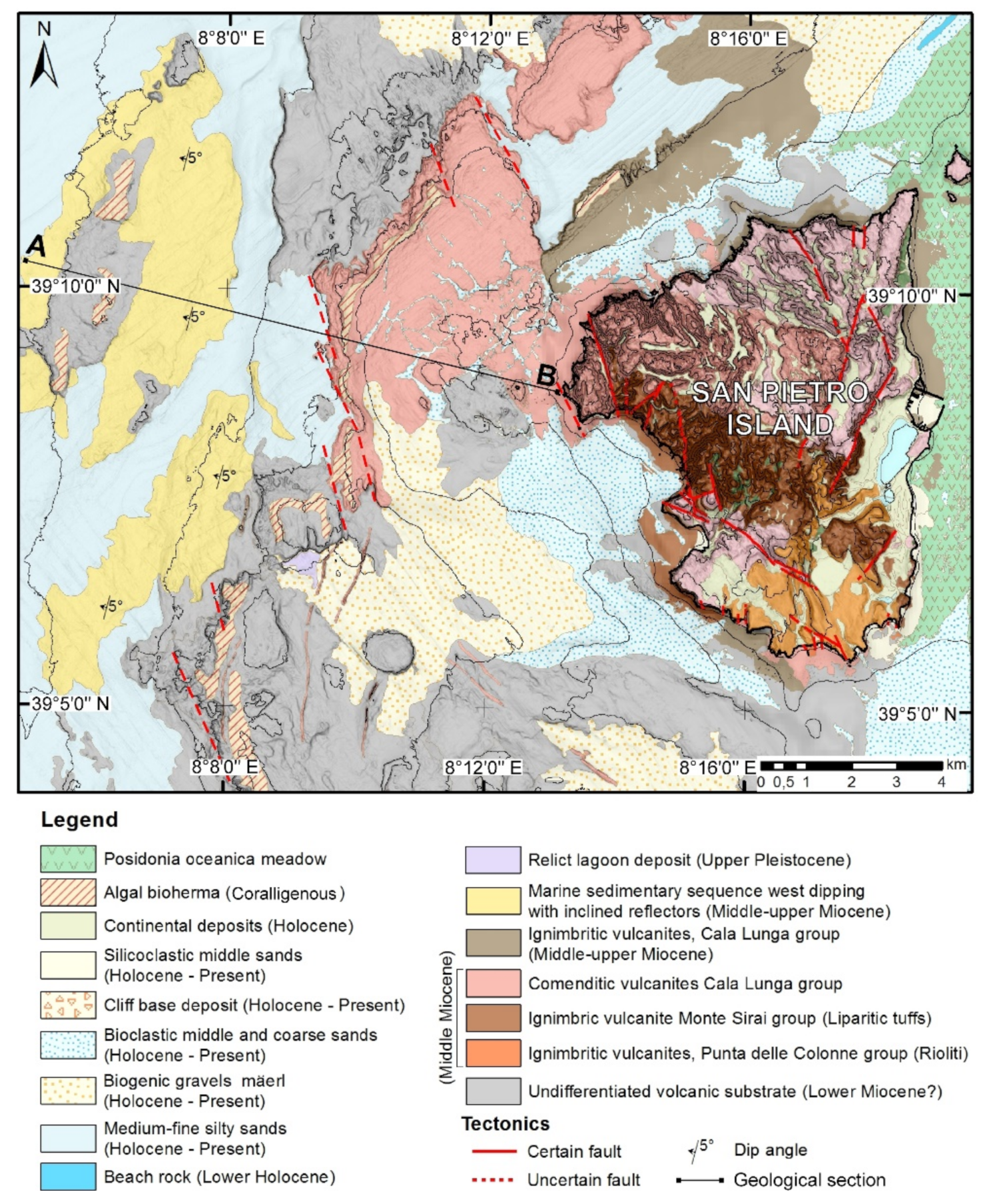

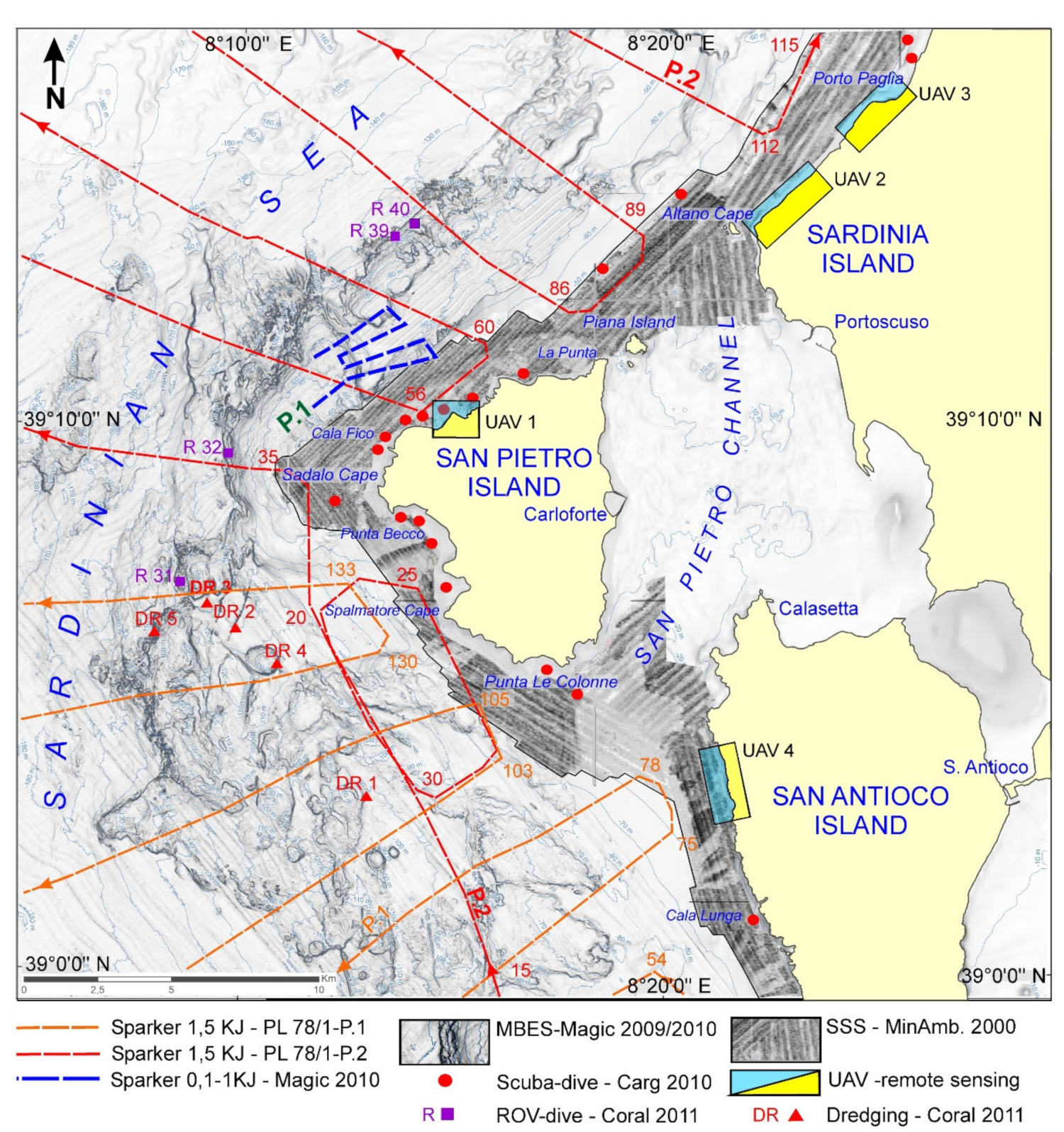


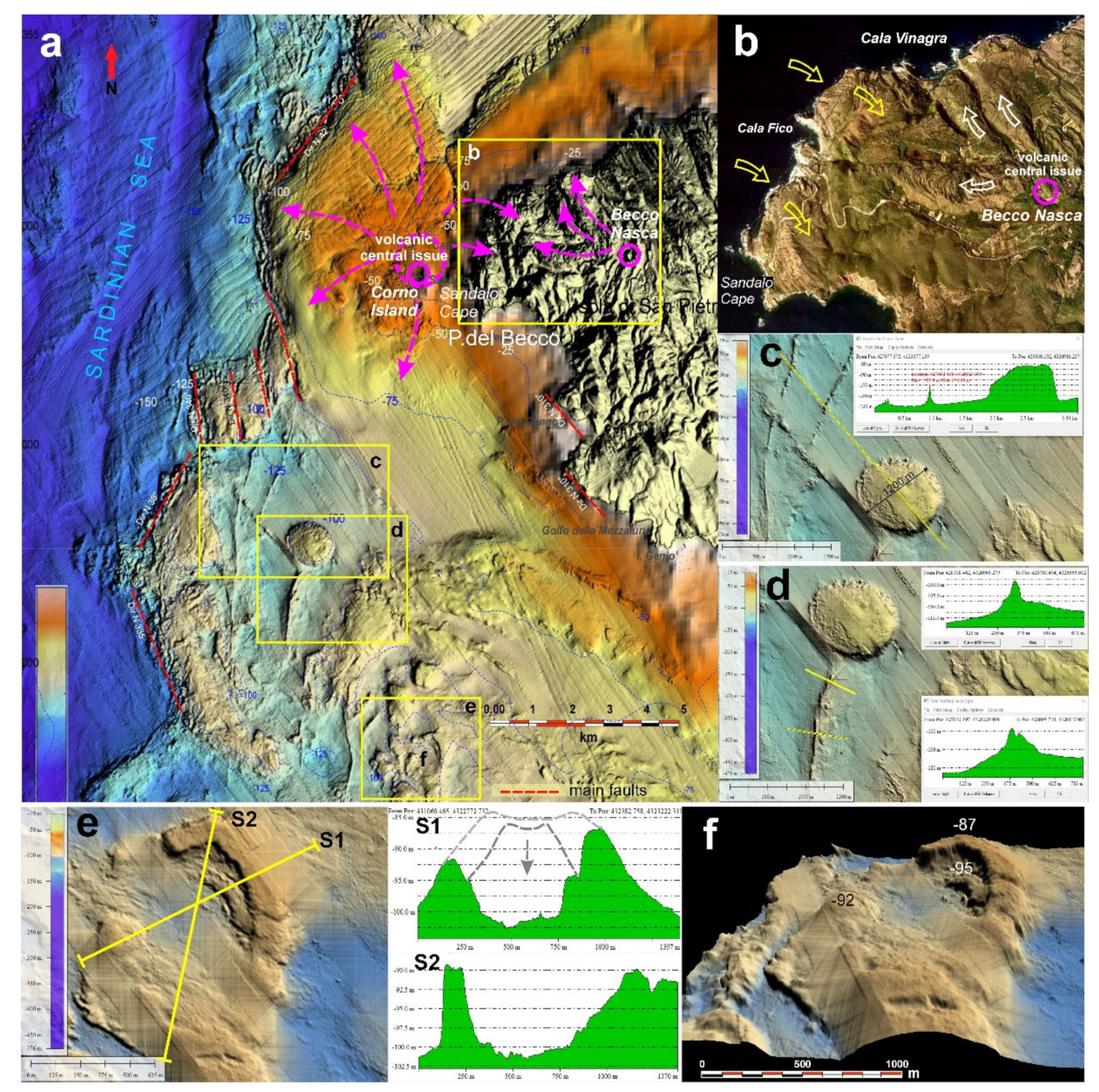
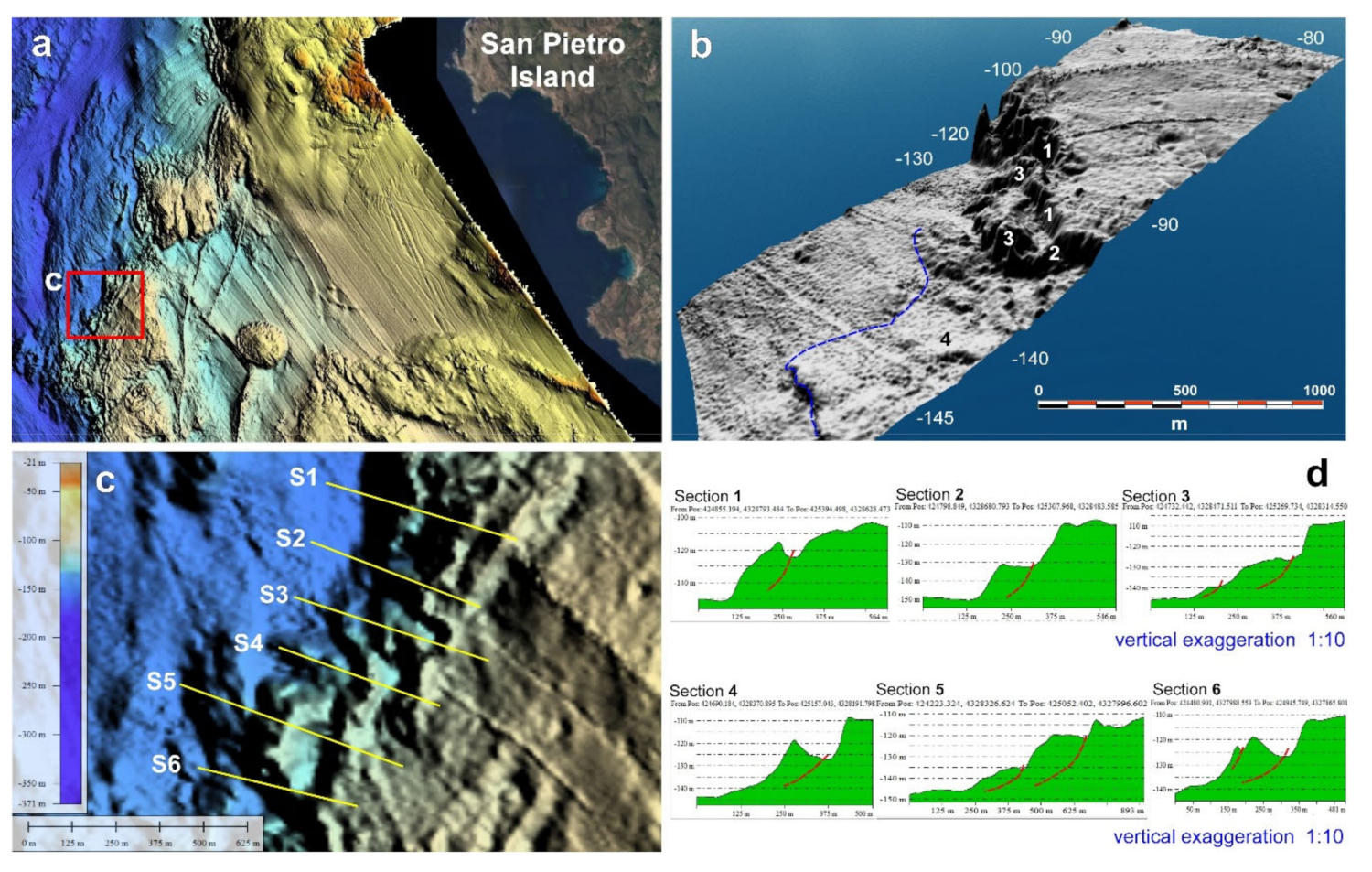
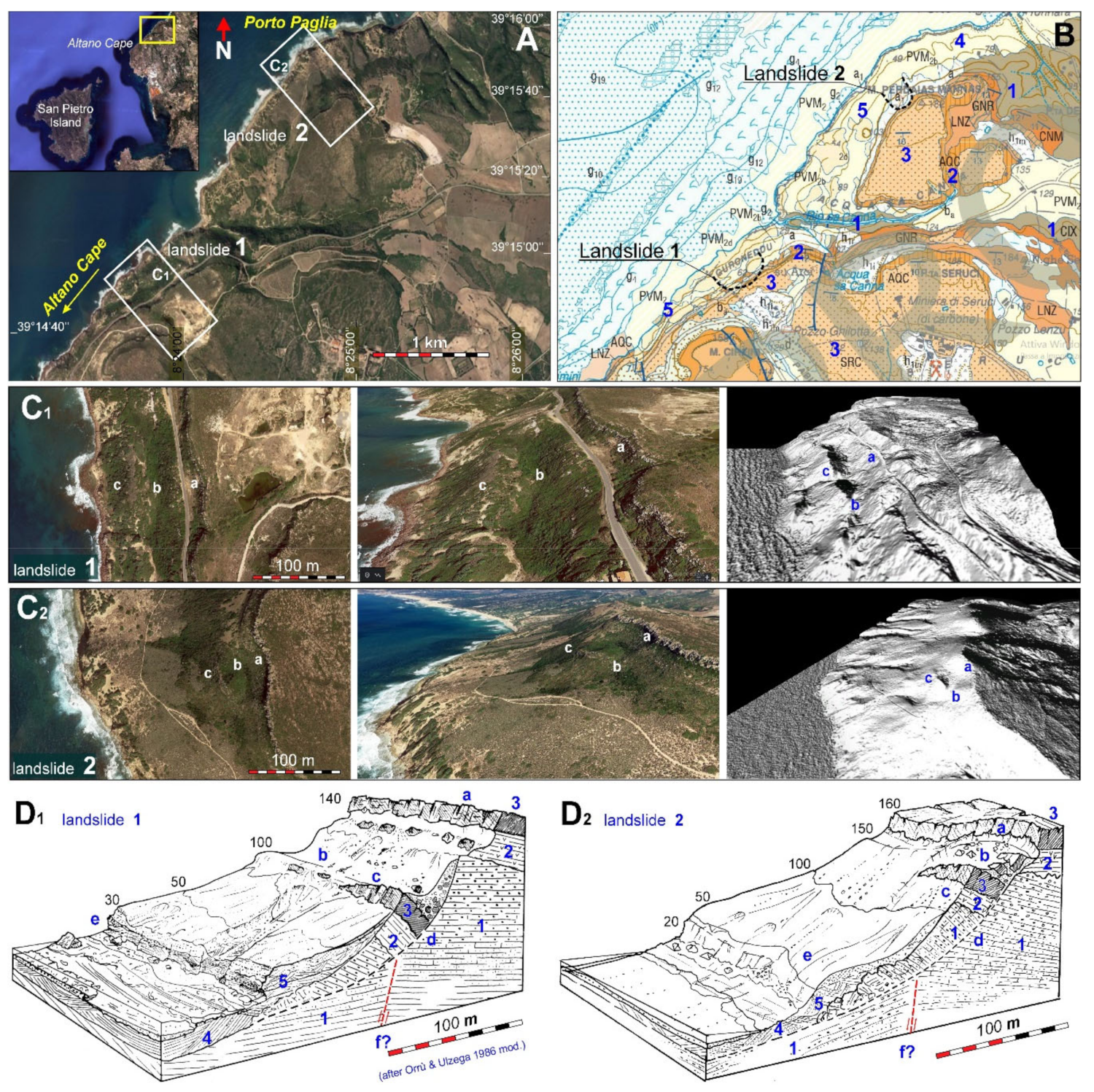
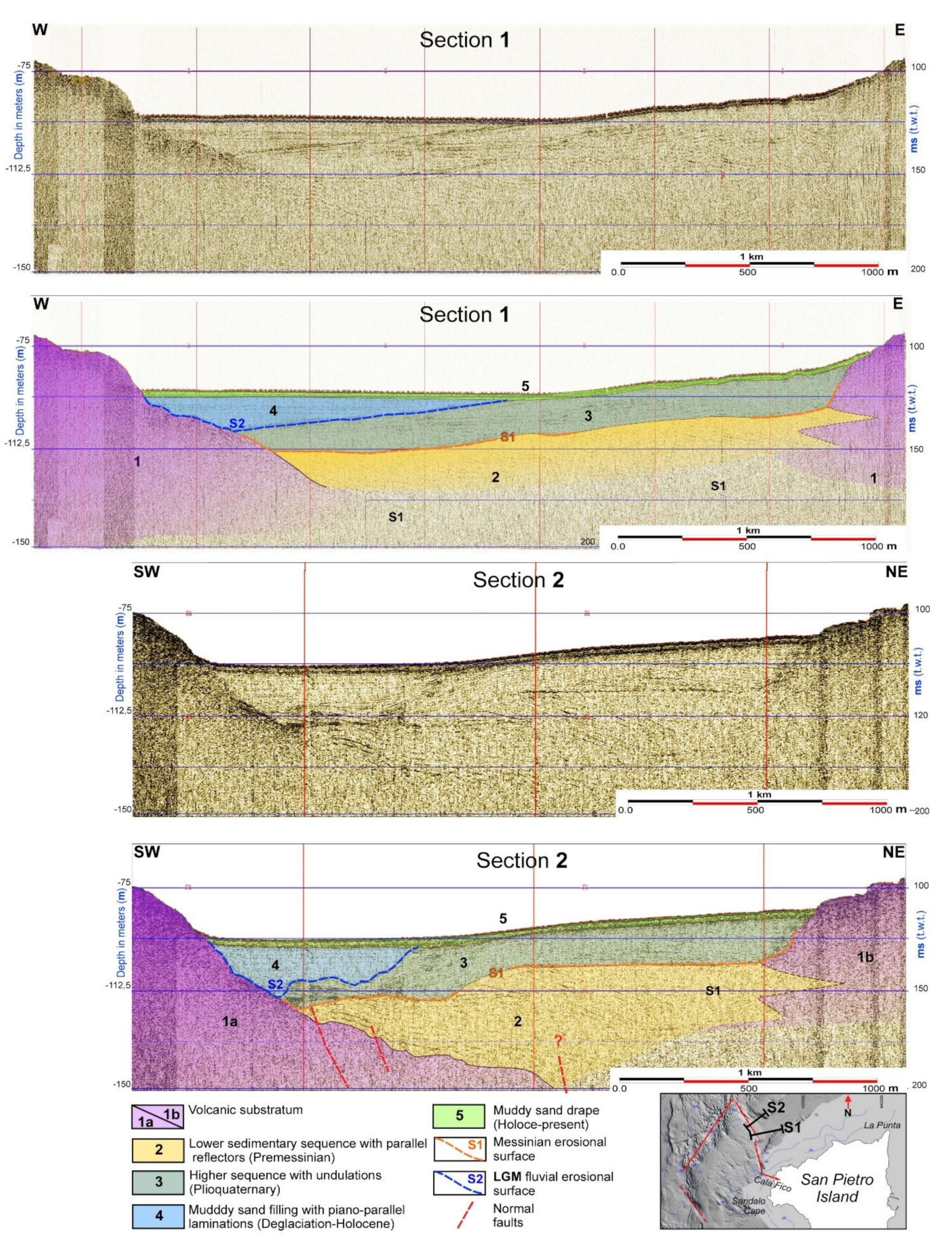
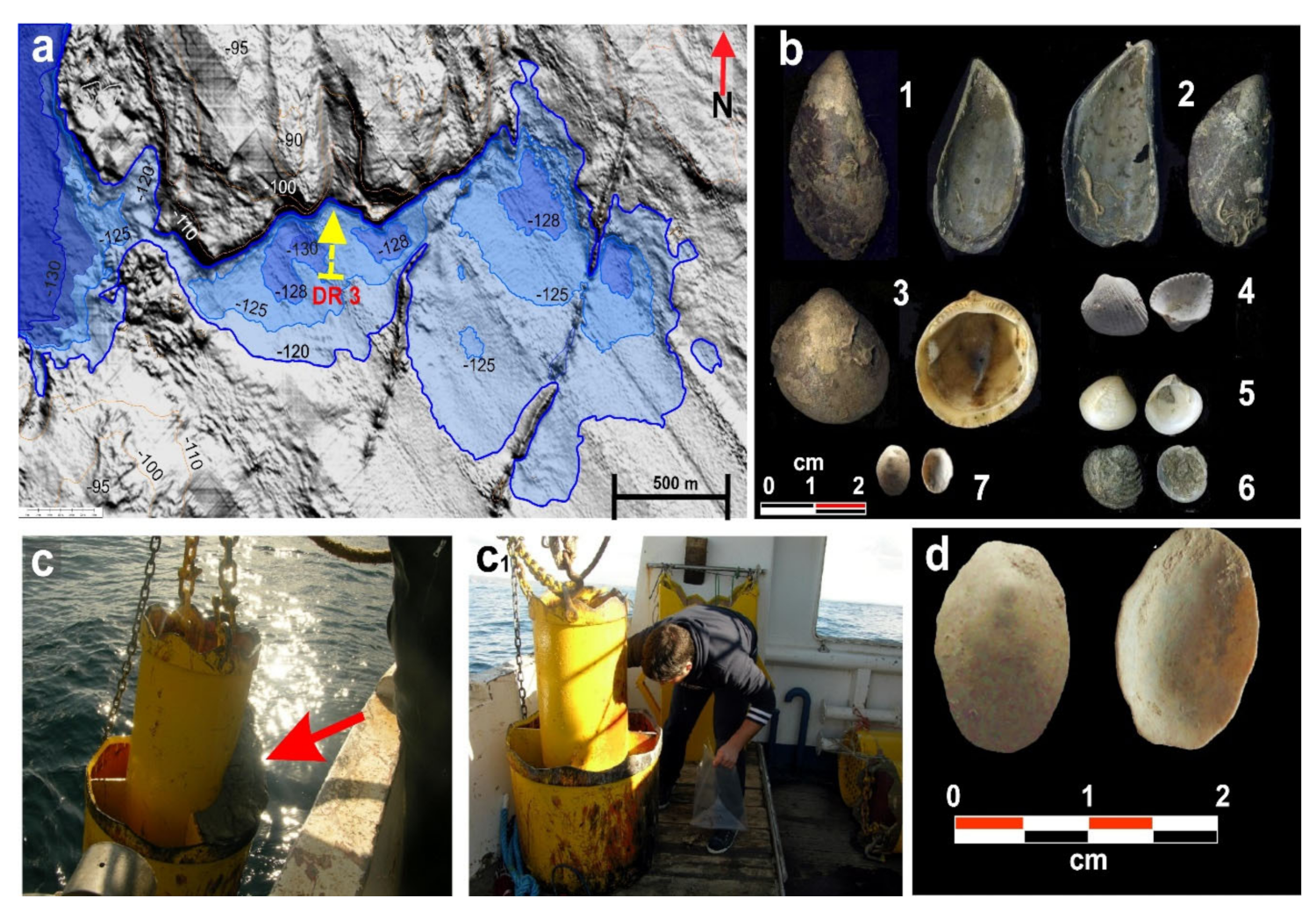
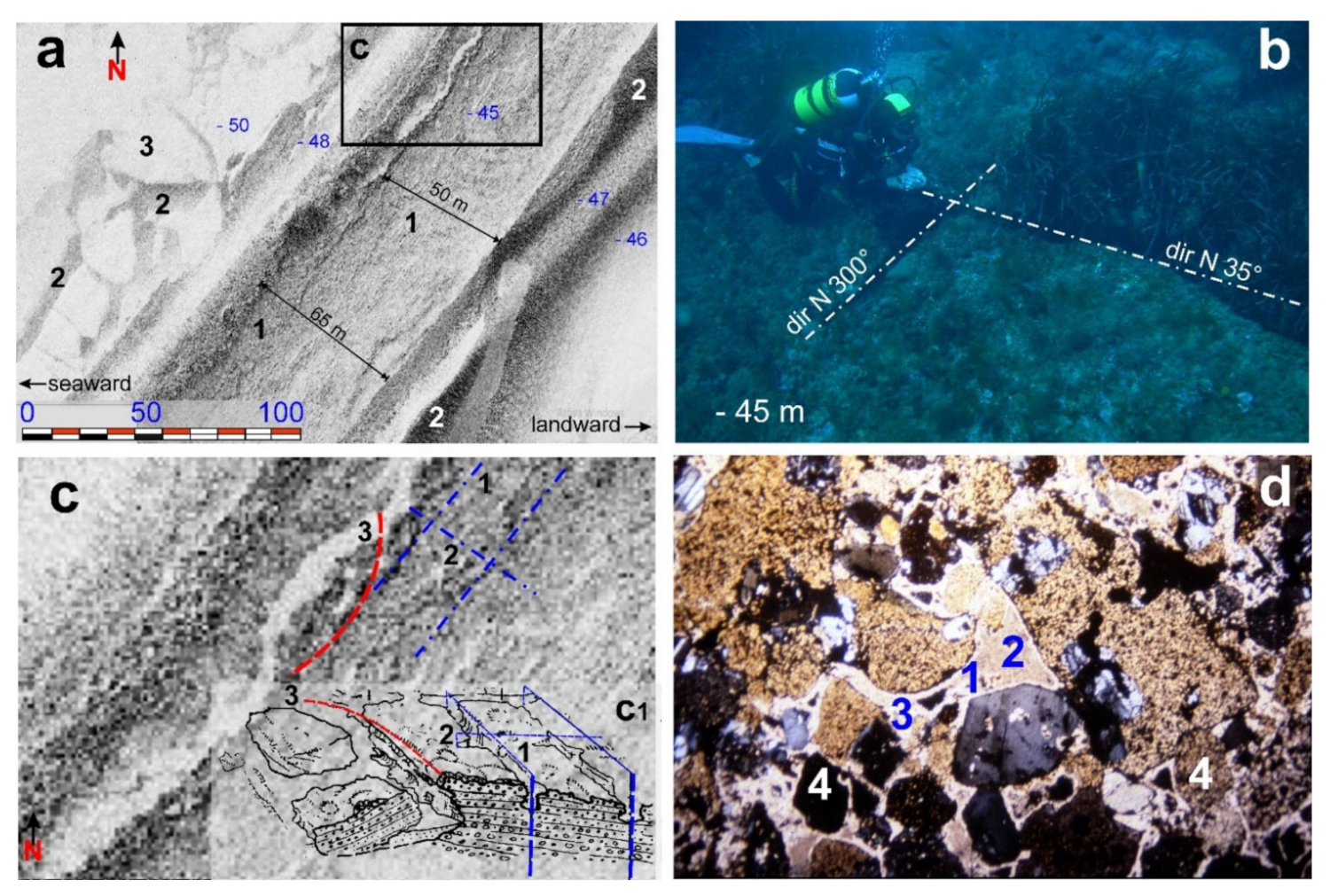

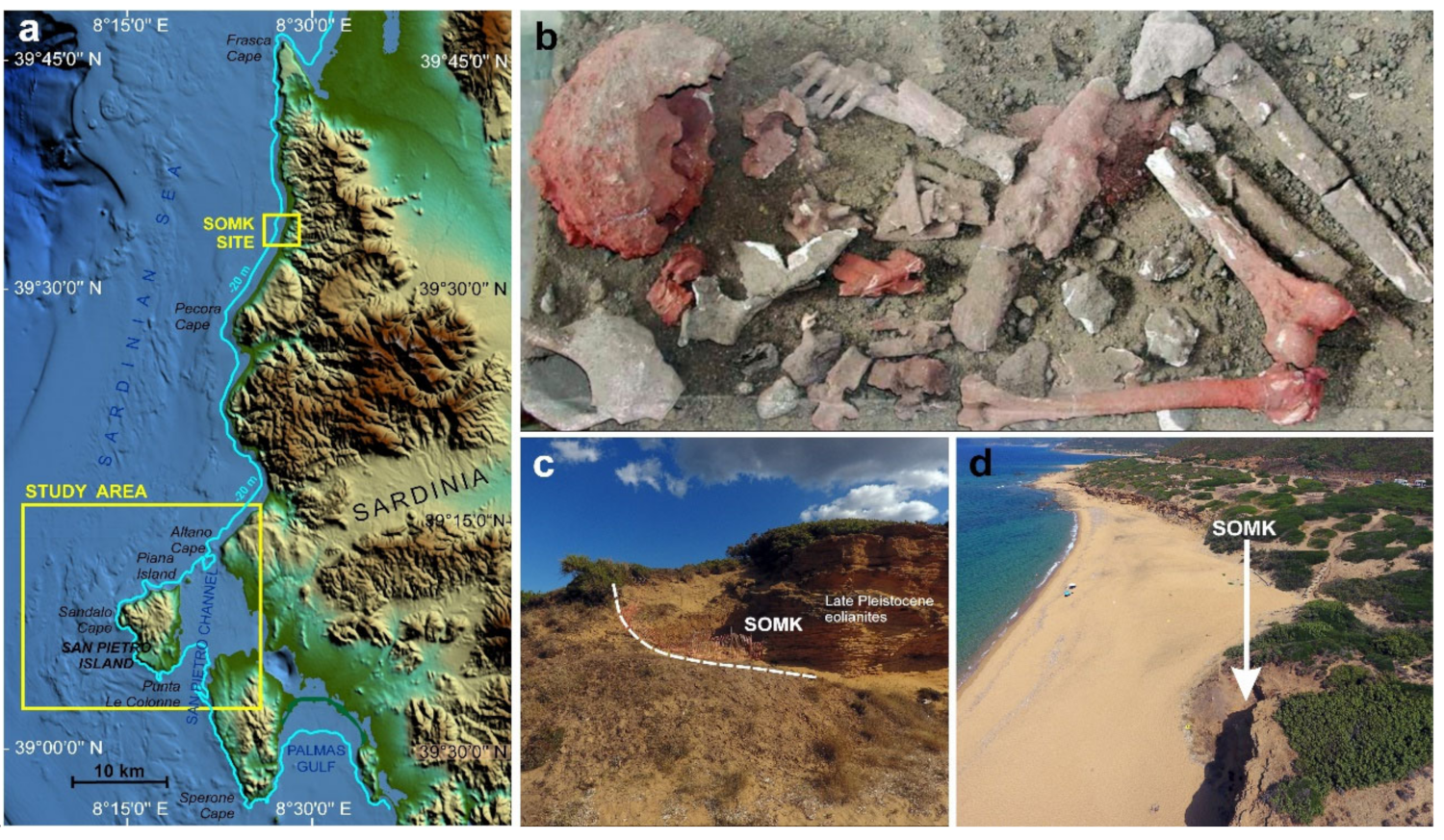
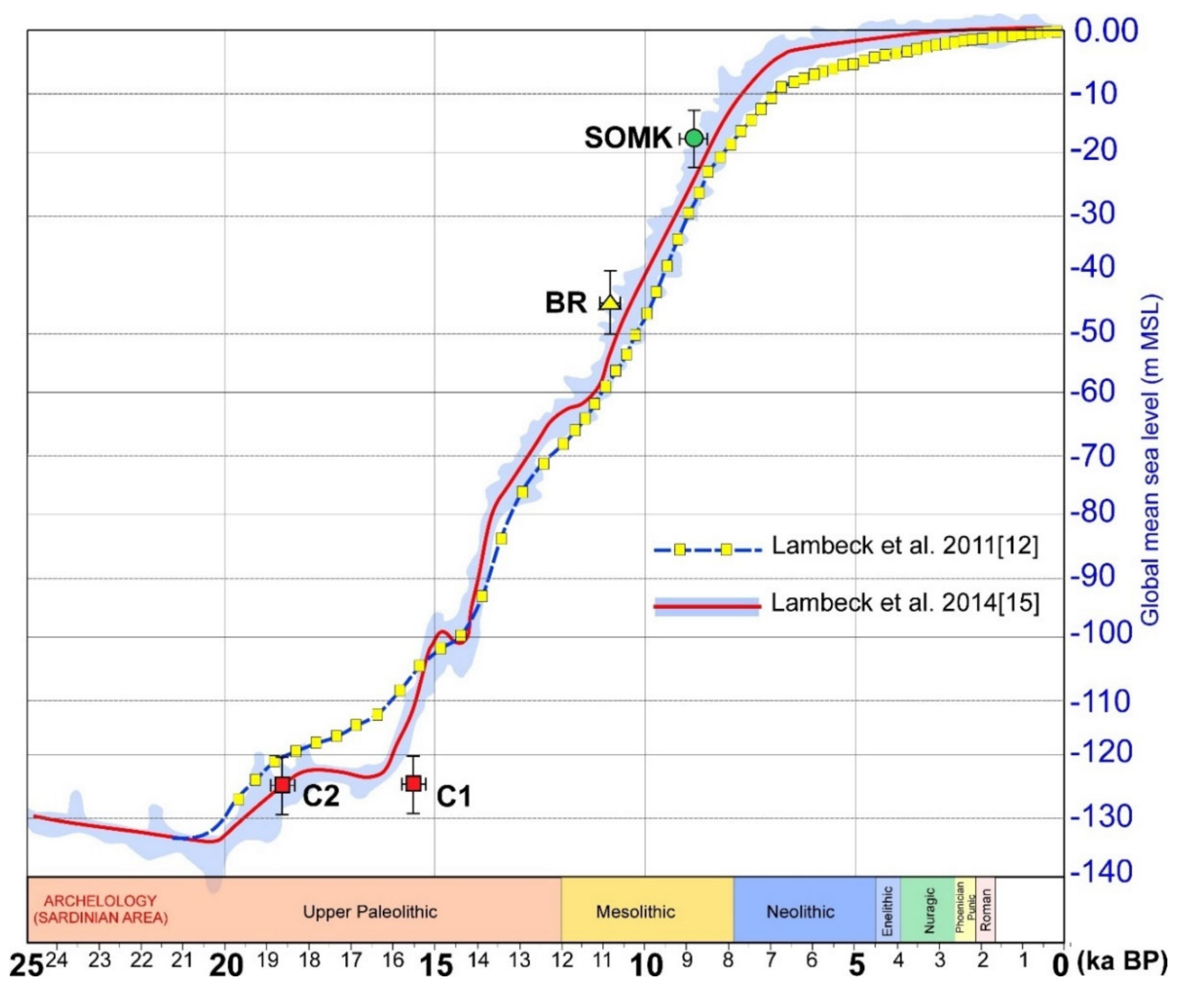
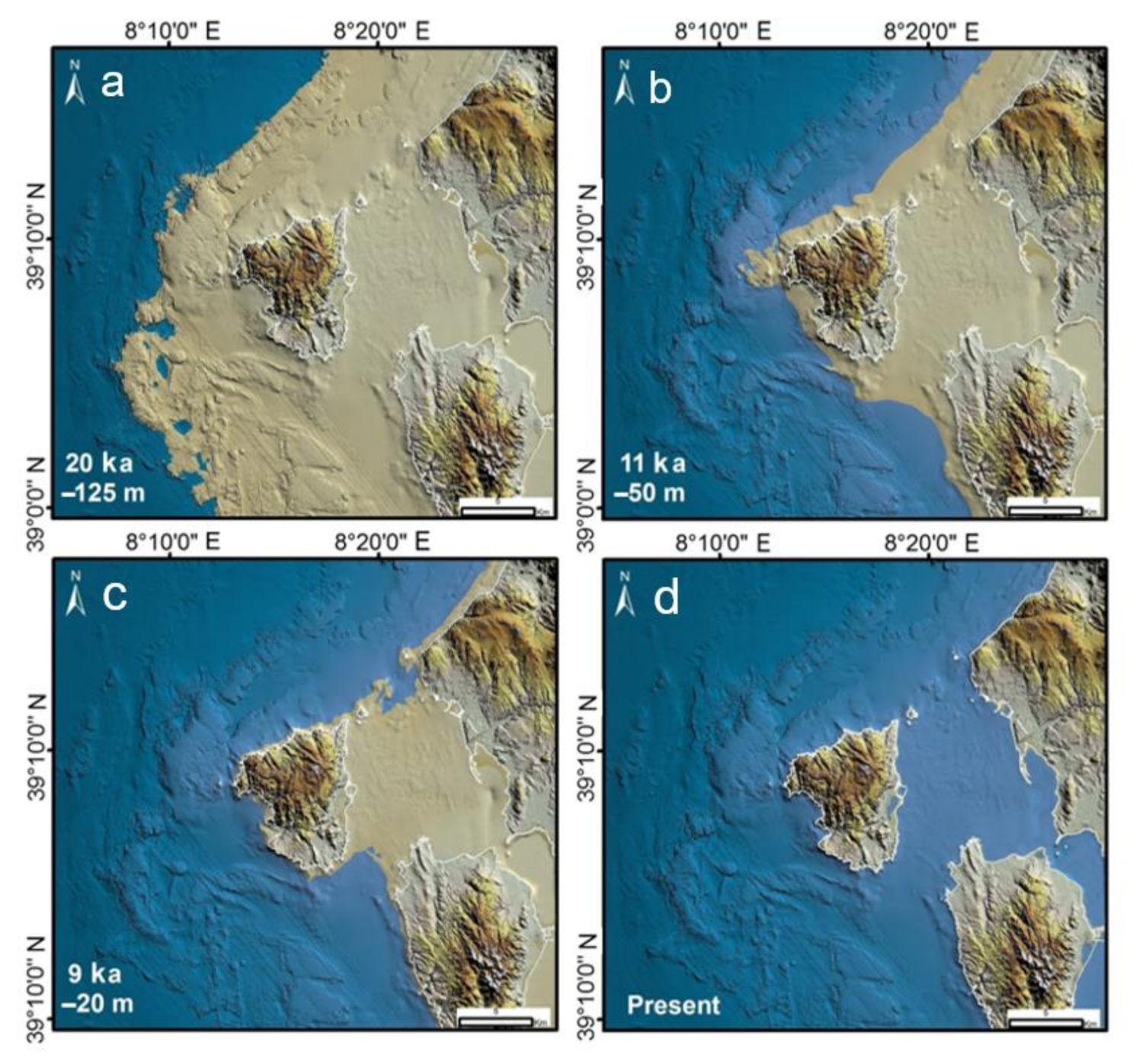
| Lab. Code | Material | Species | 13C/12C Ratio | Calibration Dataset | 14C Age (BP) | 2-σ Interval of Calibrated Age (cal yr BP) |
|---|---|---|---|---|---|---|
| Beta-310989 | shell | Mytilus cfr. Galloprovincialis | +1.7 o/oo | Calib 8.1.0 | 13,380 ± 60 | 15,014–15,688 |
| Beta-310992 | shell | Tectura virginea | +0.6 o/oo | Calib 8.1.0 | 16,350 ± 70 | 18,714–19,251 |
Publisher’s Note: MDPI stays neutral with regard to jurisdictional claims in published maps and institutional affiliations. |
© 2021 by the authors. Licensee MDPI, Basel, Switzerland. This article is an open access article distributed under the terms and conditions of the Creative Commons Attribution (CC BY) license (http://creativecommons.org/licenses/by/4.0/).
Share and Cite
Deiana, G.; Lecca, L.; Melis, R.T.; Soldati, M.; Demurtas, V.; Orrù, P.E. Submarine Geomorphology of the Southwestern Sardinian Continental Shelf (Mediterranean Sea): Insights into the Last Glacial Maximum Sea-Level Changes and Related Environments. Water 2021, 13, 155. https://doi.org/10.3390/w13020155
Deiana G, Lecca L, Melis RT, Soldati M, Demurtas V, Orrù PE. Submarine Geomorphology of the Southwestern Sardinian Continental Shelf (Mediterranean Sea): Insights into the Last Glacial Maximum Sea-Level Changes and Related Environments. Water. 2021; 13(2):155. https://doi.org/10.3390/w13020155
Chicago/Turabian StyleDeiana, Giacomo, Luciano Lecca, Rita Teresa Melis, Mauro Soldati, Valentino Demurtas, and Paolo Emanuele Orrù. 2021. "Submarine Geomorphology of the Southwestern Sardinian Continental Shelf (Mediterranean Sea): Insights into the Last Glacial Maximum Sea-Level Changes and Related Environments" Water 13, no. 2: 155. https://doi.org/10.3390/w13020155
APA StyleDeiana, G., Lecca, L., Melis, R. T., Soldati, M., Demurtas, V., & Orrù, P. E. (2021). Submarine Geomorphology of the Southwestern Sardinian Continental Shelf (Mediterranean Sea): Insights into the Last Glacial Maximum Sea-Level Changes and Related Environments. Water, 13(2), 155. https://doi.org/10.3390/w13020155







